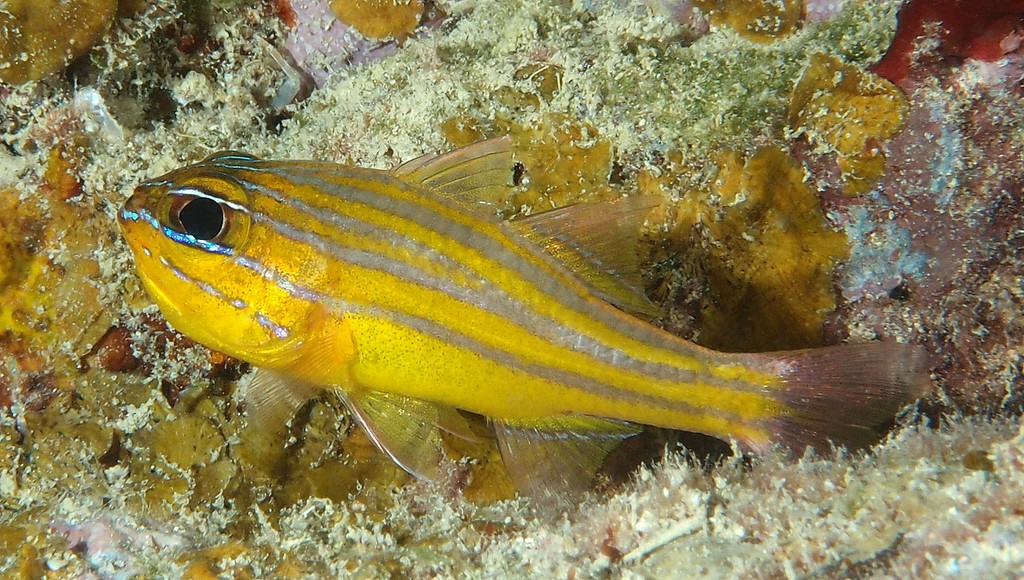OSTORHINCHUS PROPERUPTUS - (WHITLEY, 1964)
Actinopterygii (Gigaclass) > Actinopteri (Class) > Teleostei (Subclass) > Gobiiformes (Order) > Apogonoidei (Suborder) > Apogonidae (Family) > Apogoninae (Subfamily) > Ostorhinchus (Genus)
Apogon rayé de lignes dorées, Poisson-cardinal rayé de lignes d'or, Coral cardinalfish, Southern orange-lined cardinal, Southern orange-lined cardinal fish, Kinsen-ishimochi, キンセンイシモチ, 黄带天竺鲷,
Synonymes
Apogon properupta (Whitley, 1964)
Apogon properuptus (Whitley, 1964)
Jaydia properupta (Whitley, 1964)
Lovamia properupta (Whitley, 1964)
Ostorhinchus properupta (Whitley, 1964)
Apogon rayé de lignes dorées, Poisson-cardinal rayé de lignes d'or, Coral cardinalfish, Southern orange-lined cardinal, Southern orange-lined cardinal fish, Kinsen-ishimochi, キンセンイシモチ, 黄带天竺鲷,
Synonymes
Apogon properupta (Whitley, 1964)
Apogon properuptus (Whitley, 1964)
Jaydia properupta (Whitley, 1964)
Lovamia properupta (Whitley, 1964)
Ostorhinchus properupta (Whitley, 1964)
---------------------------
Description
Dorsal spines (total): 7-8; Dorsal soft rays (total): 9; Anal spines: 2; Anal soft rays: 8; Pectoral fin rays: 14; Lateral line scales: 27; Predorsal scales: 3; Greatest depth of body: 2.7-3.1 in SL. Anterior nostril with small rim, posterior elongated pear-shaped. Maxillary emarginated, reaching below posterior half of eye. Villiform teeth in bands on jaws. No canines. Palatine teeth cannot be distinguished. A U-shaped band of fine teeth on vomer with the ends of the U expanded and turned outwards. Tongue spoon-like. Orbital rim slightly roughened supero-posteriorly. Suborbital entire. Posterior margins of preoperculum serrate, anterior margins smooth. Two rows of cheek-scales. Body rather robust, its breadth less than half its depth, covered with thin but strong ctenoid scales, their serrations in more than one row. Lateral line complete, its scales about the same size as those above and below it. Suprascapula covered by scales. One or two scales between dorsal fins. No glandular peritoneal tube. Vent about halfway between ventral base and origin of anal fin. Third dorsal spine longest, first very small, about one-third of second. Second anal spine (7 mm) one-third of head. Margins of soft dorsal and anal fins sinuous. Ventrals pointed. Caudal forked, with very weak procurrent spines. Max. length: 6.0 cm TL. Depth range: 1 - 30 m, usually: 1 - 14 m.
Color
Yellow orange body color; Five narrow silvery stripes on body. Differs from other species in the disposition of the color bands, notably in that the lateral ones converge on the base of the caudal fin, without a median stripe between them, there is a V-shaped mark on top of the head whose prongs point backwards and each of which divides into a further V-shaped mark and there is a dark stripe below the eye to edge of opercle.
Etymology
Ostorhinchus: from Greek, osteon = bone + from Greek, rhynchos = beak. In reference to the bony jaws, very much advanced and jagged, which take the place of the teeth.
properuptus: from Latin, prope = near, close + from Latin, ruptus = break. Referring to yellow stripes on head and body, the first stripe running half-way along posterior dorsal-fin rays, “broken up” into a row of dark patches on the membranes.
Original description: Lovamia properupta Whitley, 1964 - Type locality: Frederick Reef, Coral Sea. Collected by Dr. D. F. McMichael, 1960.
Distribution
Indo-West Pacific: Papua New Guinea, east to Fiji, north to Japan, south to Queensland (Australia), Coral Sea and New Caledonia.
Etymology
Ostorhinchus: from Greek, osteon = bone + from Greek, rhynchos = beak. In reference to the bony jaws, very much advanced and jagged, which take the place of the teeth.
properuptus: from Latin, prope = near, close + from Latin, ruptus = break. Referring to yellow stripes on head and body, the first stripe running half-way along posterior dorsal-fin rays, “broken up” into a row of dark patches on the membranes.
Original description: Lovamia properupta Whitley, 1964 - Type locality: Frederick Reef, Coral Sea. Collected by Dr. D. F. McMichael, 1960.
Distribution
Indo-West Pacific: Papua New Guinea, east to Fiji, north to Japan, south to Queensland (Australia), Coral Sea and New Caledonia.
Biology
Usually in pairs or small aggregations, feeds on benthic invertebrates, small fish and zooplankton. Mouthbrooders. Distinct pairing during courtship and spawning.
Similar species
Ostorhinchus cyanosoma (Bleeker, 1853) - Reported from New Caledonia - Link to the species (here).
Ostorhinchus rubrimacula (Randall & Kulbicki, 1998) - Reported from New Caledonia - Link to the species (here). Distinguished from Ostorhinchus cyanosoma by the presence of a single red spot at the midbase of the caudal fin, a higher number of gill rakers, and apparently a smaller maximum size (Max. length: 4.5 cm SL). Although the species is still valid on "Eschmeyer's Catalog of Fishes", Kuiter & Kozawa, 2019 believe that Ostorhinchus rubrimacula would be a synonym of Ostorhinchus cyanosoma based on a description made at night. The red dot at the base of the caudal fin would be present only at night.
Similar species
Ostorhinchus cyanosoma (Bleeker, 1853) - Reported from New Caledonia - Link to the species (here).
Ostorhinchus rubrimacula (Randall & Kulbicki, 1998) - Reported from New Caledonia - Link to the species (here). Distinguished from Ostorhinchus cyanosoma by the presence of a single red spot at the midbase of the caudal fin, a higher number of gill rakers, and apparently a smaller maximum size (Max. length: 4.5 cm SL). Although the species is still valid on "Eschmeyer's Catalog of Fishes", Kuiter & Kozawa, 2019 believe that Ostorhinchus rubrimacula would be a synonym of Ostorhinchus cyanosoma based on a description made at night. The red dot at the base of the caudal fin would be present only at night.
Last update: 6, May 2024
